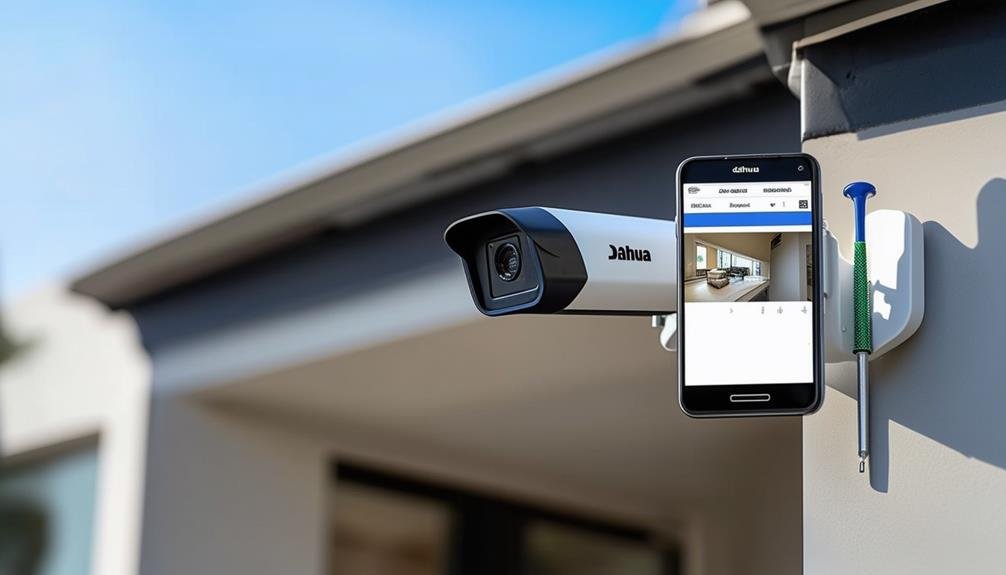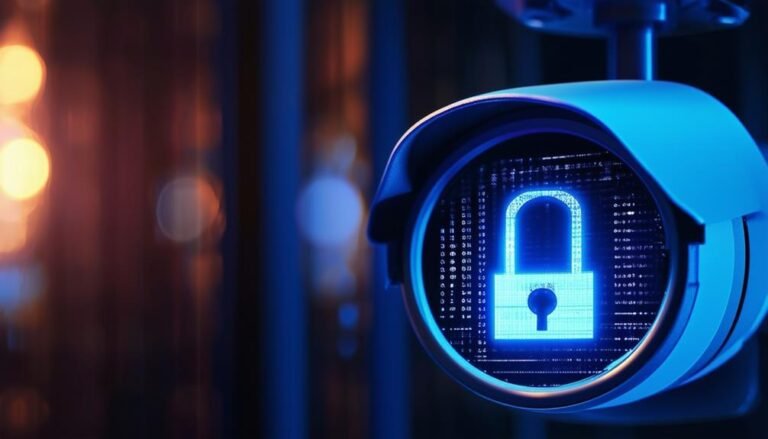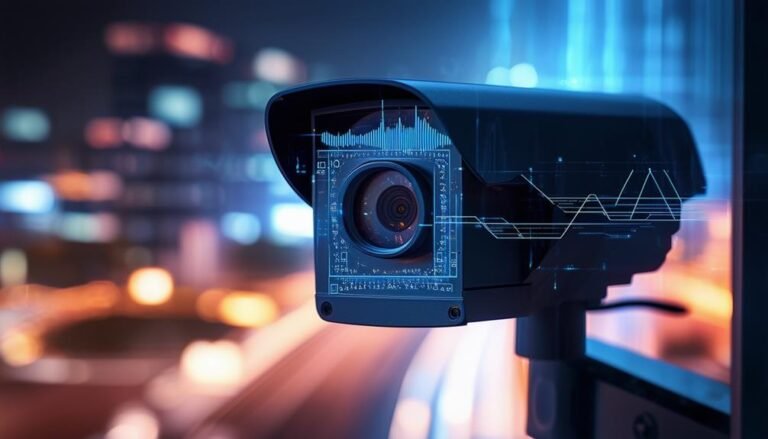Setting up your Dahua IP camera's straightforward. First, unbox the camera and gather the included components. Choose a location with good coverage and mount the camera securely. Connect it to your network either via Ethernet for stability or Wi-Fi for flexibility. Access the camera's interface using its IP address and default credentials to configure settings like image quality, motion detection, and notifications. Once set up, you can view the live feed through a browser or the Dahua app. For tips on troubleshooting common issues, keep exploring further!
Unboxing Your Dahua IP Camera
When you finally get your hands on a Dahua IP camera, it's exciting to unbox it and see what's included. You'll likely find the camera itself, a power adapter, and a user manual that'll guide you through the setup process. Take a moment to appreciate the sleek design and robust build—this isn't just any camera; it's a tool that'll give you the freedom to monitor your surroundings securely.
Next, you'll come across mounting hardware, which is vital if you're planning to install the camera in a fixed location. This hardware often includes screws, anchors, and a template to help guarantee a level installation. Make sure to keep everything organized; you won't want to misplace an important piece when you're ready to set it up.
Don't forget the network cable, if it's wired, or the additional components for wireless connectivity. Each part plays a role in giving you the autonomy to monitor your space without constant worry. Check for any additional accessories, like a protective cover or a memory card, that may enhance your camera's functionality.
As you unbox each item, think about the possibilities ahead. With this camera, you're embracing a sense of control over your environment, allowing you to observe and protect what matters most. So, take a deep breath, get inspired, and prepare to plunge into the world of security that awaits you. Your journey begins now!
Physical Installation Steps
How do you get your Dahua IP camera securely installed? It's all about finding the right spot, ensuring stability, and taking care of the wiring. Here's how to do it with ease:
- Choose the Right Location: Think about where you want to install the camera. Ideally, it should be a place that covers your desired area, like entryways or driveways. Make sure it's out of reach from potential tampering and avoids direct sunlight to prevent glare.
- Mounting the Camera: Once you've chosen the spot, it's time to mount the camera. Use the provided mounting bracket and mark the drilling points on the wall or ceiling. Drill holes and insert wall anchors if necessary. Secure the camera firmly, ensuring it's positioned at an advantageous angle for viewing.
- Run the Cables: If your camera requires a power supply or Ethernet connection, carefully run the cables. Conceal them as much as possible to maintain aesthetics and deter tampering. If you're using a PoE (Power over Ethernet) setup, one cable will handle both power and data, simplifying your installation.
Once you've completed these steps, take a moment to double-check that everything is secure and aligned. A well-installed camera not only enhances your security setup but also gives you peace of mind. Enjoy the freedom that comes with knowing your surroundings are being monitored!
Connecting to Your Network
Connecting your Dahua IP camera to your network is essential for accessing its features and monitoring capabilities. To get started, you'll need to decide between a wired or wireless connection. A wired connection typically offers a more stable and faster connection, while a wireless setup gives you the flexibility to place your camera almost anywhere.
If you're going the wired route, plug one end of an Ethernet cable into the camera and the other into your router or switch. Make sure your router is powered on and ready. For a wireless connection, first, power up your camera and make sure it's within range of your Wi-Fi signal.
Next, you'll need to access the camera's web interface. Open a web browser and enter the camera's default IP address, which is usually found in the user manual. If you're unsure, you can use the Dahua Config Tool to detect the camera on your network.
Once you reach the login page, enter the default username and password—these are typically "admin" and "123456." After logging in, navigate to the network settings to configure the Wi-Fi connection. Select your network, enter the password, and save the settings.
After a quick reboot, your camera should connect to the Wi-Fi network. To verify the connection, try accessing the camera's feed through your web browser or the Dahua app on your smartphone. You're now ready to embrace the freedom of remote surveillance!
Configuring Camera Settings
Now that your Dahua IP camera is connected to your network, it's time to configure the settings for ideal performance. You'll need to access the camera interface to adjust image quality and set up motion detection features. Let's go through these important steps to guarantee your camera meets your needs.
Accessing Camera Interface
Once you've powered on your Dahua IP camera and confirmed it's connected to your network, accessing the camera interface becomes vital for configuring your settings. This step is essential for releasing the full potential of your camera, allowing you to customize it to your needs. Here's how you can access the interface:
- Open a Web Browser: Launch your preferred web browser on a device connected to the same network as your camera.
- Enter the Camera's IP Address: Type the camera's IP address in the browser's address bar. This can typically be found in your router's DHCP client list or through the Dahua configuration tool.
- Log In: When prompted, enter the default username and password (usually admin/admin) unless you've changed them.
Once you're logged in, you'll have access to various settings that let you tailor the camera's performance. Don't forget to change the default login credentials for added security! Enjoy the freedom of customizing your surveillance experience.
Adjusting Image Quality
Typically, adjusting the image quality settings on your Dahua IP camera is essential for ensuring ideal video clarity and performance. You'll want to start by logging into your camera's interface. Once you're in, navigate to the image settings section. Here, you can tweak several parameters to match your needs.
First, focus on the resolution. Higher resolutions provide clearer images but may require more bandwidth. If you're aiming for detailed footage, consider setting it to 1080p or higher. Next, adjust the frame rate. A higher frame rate results in smoother video, especially for fast-moving subjects, but again, be mindful of your bandwidth limitations.
Don't forget about brightness, contrast, and saturation. These settings can greatly impact how your footage looks. Experiment with these values until you find a balance that suits your environment. If your camera has an option for day/night mode, enable it to enhance image quality in varying lighting conditions.
Setting Motion Detection
After adjusting the image quality settings, it's time to focus on setting up motion detection. This feature allows you to monitor specific areas and only record when something happens, giving you more control over your footage and storage. Here's how to set it up:
- Access the Camera's Interface: Log in to your Dahua camera's web interface. Navigate to the "Configuration" menu and select "Event" to find the motion detection settings.
- Define Motion Detection Areas: You can set specific zones where you want the camera to detect motion. This prevents unnecessary alerts from passing cars or trees swaying in the wind. Adjust the sensitivity level to guarantee it captures relevant movements without triggering false alarms.
- Set Notification Preferences: Choose how you want to be notified when motion is detected. You can opt for email alerts, push notifications, or even integrate with your smart home system.
Accessing Live Feed
Accessing the live feed from your Dahua IP camera is a straightforward process that allows you to monitor your property in real-time. First, make certain your camera is powered on and connected to your network. You can do this through Wi-Fi or an Ethernet cable, depending on your setup preference.
Next, open a web browser on your computer or mobile device. Enter the IP address of your camera into the address bar. If you've set everything up correctly, you'll be prompted to log in. Use the username and password you created during the initial setup. If you haven't changed them, it might still be the default settings, which you can find in your camera's manual.
Once logged in, you'll see a live view option on the interface. Click on it, and voila! You're now watching the live feed. You can adjust the camera angle or zoom in and out using the controls provided. This freedom to see what's happening in real-time gives you peace of mind, whether you're at home or away.
If you're using a mobile device, you might prefer downloading the Dahua app, which offers an easy way to access your camera's live feed. Just log in with your credentials, and you'll be able to view your camera feed on the go. This flexibility guarantees you're always in control and can keep an eye on what matters most to you.
Troubleshooting Common Issues
When you're trying to access your Dahua IP camera, you might run into some common issues that can be frustrating. But don't worry; troubleshooting these problems is usually straightforward. Here are a few steps you can take to regain control and guarantee your camera's functioning smoothly.
- Network Connection: First, check your network connection. Confirm that your camera is properly connected to your router or switch. If you're using Wi-Fi, verify that the signal is strong enough. Sometimes, simply rebooting your router can resolve connectivity issues.
- IP Address Conflicts: Next, make sure your camera's IP address doesn't conflict with another device on your network. Use a network scanner to identify devices and verify that your camera has a unique IP address. If there's a conflict, you can either change the camera's IP through its web interface or assign a static IP outside of the DHCP range.
- Firewall Settings: Finally, examine your firewall settings. Sometimes, security software can block access to your camera. Temporarily disable your firewall to see if that's the issue. If it is, you'll need to create an exception for your camera in the firewall settings.
Frequently Asked Questions
What Power Supply Does My Dahua IP Camera Require?
When considering the power supply for your Dahua IP camera, you might feel torn between the ease of plug-and-play setups and the desire for a robust, reliable power source. You'll typically need a 12V DC power supply. Depending on your camera model, it could require anywhere from 1A to 2A. Make sure to check the specifications, as a mismatched supply could limit your camera's performance, restricting the freedom of your surveillance capabilities.
Can I Use Third-Party Software With My Dahua Camera?
Yes, you can use third-party software with your Dahua camera, but it's important to verify compatibility. Many users appreciate having options to customize their surveillance experience. Just keep in mind that using unsupported software might limit some features or functionalities. Always check for updates and support from both the camera manufacturer and the third-party provider to verify a smooth integration. Enjoy the flexibility and control over your security system!
How Do I Reset My Dahua IP Camera to Factory Settings?
If you're looking to reset your Dahua IP camera to factory settings, you're not alone; many people seek a fresh start with their devices. To do this, you'll typically find a reset button on the camera itself. Press and hold it for about 10 seconds until the LED indicator flashes. This action restores the original settings, freeing your device from any previous configurations. Just remember, you'll need to set it up again afterward!
Is My Dahua Camera Compatible With Smart Home Systems?
Your Dahua camera's compatibility with smart home systems can depend on the specific model you have. Many Dahua cameras support integration with popular platforms like Google Home, Amazon Alexa, and others. To check, you can look at the product specifications or the Dahua website for details on smart home compatibility. If it supports ONVIF or RTSP, there's a good chance you can link it with your smart home setup easily.
Where Can I Find Firmware Updates for My Dahua IP Camera?
To find firmware updates for your Dahua IP camera, you should visit the official Dahua website. They usually have a dedicated support section where you can download the latest firmware for your specific camera model. Make sure to check the release notes to understand what's new or fixed. It's also a good idea to keep an eye on forums or community groups, as users often share helpful insights and updates.



